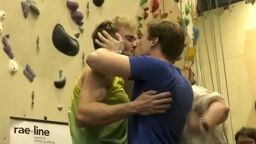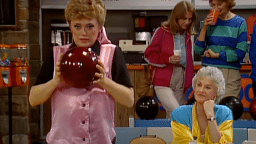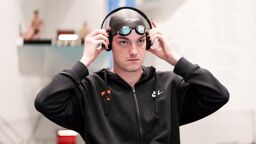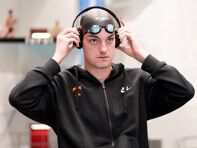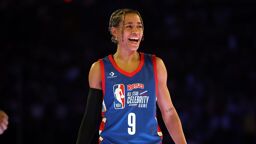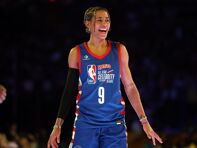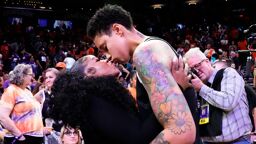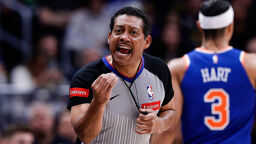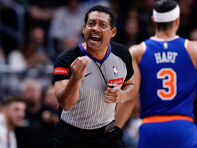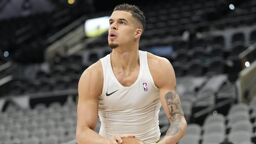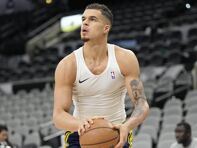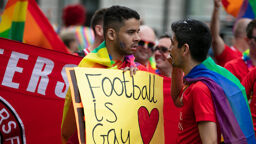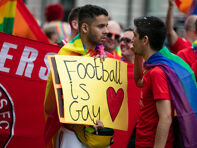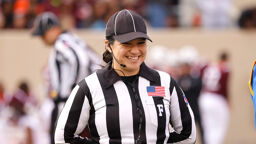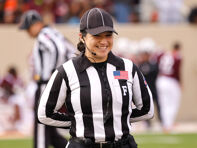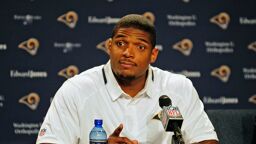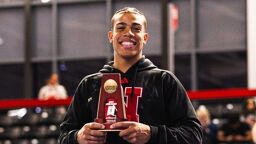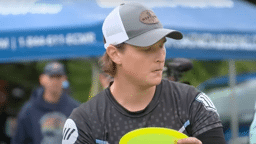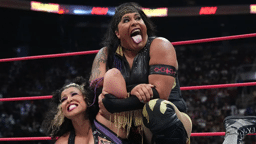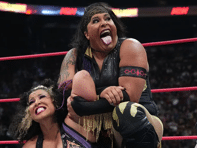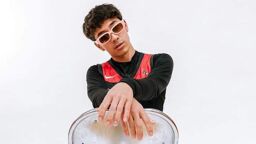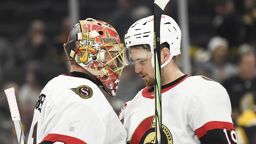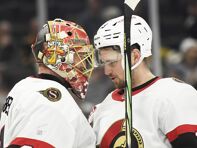Chris Clemmow's teammates in England set him up with guys in a culture where same-sex attraction is no big deal.
By Eric Anderson
Outsports.com
BATH, England — I stopped Chris after the conclusion of my sociology of sexualities lecture, telling him that I wanted to interview him. “What for,” he asked. I informed Chris that I have been researching gay and bi men in sport for years now, and that because he was an openly bisexual rugby player at a top-ranked English university rugby team, I wanted to here his story. “I’m happy to meet with you,” he said, “But I don’t have a story.” I laughed a bit inside, “We all have a story, Chris.”
Chris Clemmow and I sat down to eat the following week. He ate a surprisingly small amount for a 230-pound rugby player. I finished my meal well before him, put my fork down and agreed with him, “Chris, you really don’t have a story. And that is the story.”
I thought I was pretty good at teasing out the inerrancies of athletes’ stories. I have been interviewing out athletes ever since I came out as an openly gay high school coach in 1993. I learned that things are never as they first appear.
 |
| Chris Clemmow |
During the early to mid 1990’s there were few stories about openly same-sex attracted male athletes to be heard at all. When one could find a same-sex attracted athlete, their stories normally centered on the player only being out to a select individual or few on his team. Athletes often described themselves as belonging to a secret society of those who knew.
Later stories, those emerging from the late 1990’s until about 2003, also had a common theme. Here, only top-notch athletes came out to their teams. These athletes maintained that all was excellent, that there was no homophobia on their teams. As I interviewed these athletes, asking them to elaborate, the nitty-gritty of homophobia and heterosexism often emerged. Their outings were successful because they had proven their worth among their peers as outstanding athletes, first. About half of these athletes found themselves in don’t-ask, don’t-tell situations.
However, by the time my book, “In the Game: Gay Athletes and the Cult of Masculinity,” went to print in 2005, I was noticing yet another trend. The last section I penned concerned the evolving coming out story. Increasingly, I found same-sex attracted athletes coming out who were not superstars. Furthermore, the drama (and horror) of the old coming out narrative seemed to be fading.
Some of you might remember the story of openly gay high school football player Corey Johnson a decade ago. He came out to his football team and was met with approval through his team’s playing and singing along to the Village People’s song, “YMCA,” on a bus ride. Conversely, others might recall a story I wrote about a closeted high school basketball player whose boyfriend died and he had to grieve in private. These narratives are great stories because they maintain the necessary preliminary tension, the conflict, and often the resolution that sells Hollywood scripts. Chris’ story, however, maintains none of this. There is no grand coming out, no celebration of his sexuality, no evil homophobic villain, or social exclusion. Simply, put, Chris is just out, and that’s that.
Chris knew he liked girls before boys (a common theme with bisexual men), but he was out with his bisexuality long before coming to university. Once arriving at the University, he saw a cute guy on the dance floor. Chris went over and started kissing him; he didn’t think about how it would be perceived among his teammates.
Perhaps to the surprise of readers, this action was not in itself enough to inform his teammates that he is attracted to men. This same-sex kissing would not generate the same head turning that it would in the States. I have found that about 91% of the men at my university regularly (and passionately) kiss (or “pull” in English slang) one another on the lips. These kisses sometimes occur at home or other private settings, but they proliferate in bars and clubs, where men’s bodies also grind and gyrate with one another, generally more than they do with women’s.
Making out with another guy on the dance floor is less common, but still frequent. I find somewhere between 30% and 40% of the self-identified straight men at my university engage in pulling other guys when drunk. For those in disbelief, the photos are all over Facebook. For those of you outside this culture, you might be tempted to explain away these behaviors as a mass mocking of homosexuality. I assure you, however, it is not. Instead, these men are free to behave this way because they exist within in a culture of decreased homohysteria. When men cease to fear being homosexualized for their gendered or sexual behaviors; when they no longer care whether people think they are gay, straight or bi, these are the kinds of same-sex behaviors that can occur among heterosexual men.
Chris’s pull, however, was longer than is yet customary for two heterosexual men on the dance floor. Accordingly, the following day I heard from one of my students, “Did you hear about the rugby player pulling a guy at Score? It went on a long time.” “No,” I answered. “Was he gay, straight, or bi?” “I don’t know, he answered.” I later heard that there was an openly bisexual player on the team. I was pleased, but not surprised. I had conducted extensive research on this team a few years earlier and apart from finding an amazingly homophobic coach (who is no longer there), none of the players maintained homophobic sentiment; most had good gay friends.
I ran through my reservoir of questions, asking Chris all the usual stuff about social inclusion. Was he invited to the parties, did the guys share a bed with him on overnight trips, did they talk about his sexuality, etc. Remarkably, all of his answers and examples indicated that he was just another, accepted, member of the team. He was neither the most popular, nor reviled. Chris had no stories of homophobia, and didn’t feel different to his mates in any capacity. However, one aspect to his story did fascinate me: The guys on this team failed to discuss with him his sexuality.
Normally the lack of discussion of one’s sexuality indicates a don’t-ask, don’t-tell culture. But that doesn’t appear to be the case with Chris. When he is out clubbing with his teammates, they introduce Chris to their other gay mates. “They try to set me up,” Chris says. “With boys and girls,” I ask? “Or just girls?” “Pretty much with just guys,” he answers. There are more than 30 heterosexual guys on this team, so a teammate could introduce a woman to any of the players. But when a friend runs into a gay or bisexual male friend at a club, he introduces him to Chris. It is perhaps this reason that Chris’s teammates don’t ask Chris too many questions about same-sex sex. These men have grown up with gay and bisexual friends; they live with them, and have had the discussions before. There is far less to inquire about, than occurred with same-sex attracted athletes a decade ago. To them, Chris is bi, and that’s that.
At just 20, it is fair to say that Chris is pleasantly naïve about the history and status of same-sex attracted men in sport. He was shocked to learn that there has never been an out player in the NBA, MLB, NFL or NHL. He did not understand why there had never been one in English Rugby, either. I told Chris about the power of gay marketing and sponsorships. Explaining to him that the first would likely receive a whirlwind of lucrative sponsorships. “Well, if people really care that much, perhaps I’ll be the first,” he said.
Indeed, as a starting player on a nationally ranked team (as just a sophomore) Chris might maintain the ability to matriculate through the ranks and emerge as the first openly bisexual player. “But if someone beats you to it,” I laughed with sincerity, “there will only be scraps left for you.” Chris laughed, and left food on his plate. It was the most stereotypic "gay" thing I have yet to see him do. The boy doesn’t dance, he doesn’t dress particularly well, and it is rare to see him publicly gawk over a passing male. Conversely, he doesn’t act in stereotypical macho ways either. He doesn’t sexualize women, posture himself as aggressive, or talk obsessively about sport. He is just Chris.
There is a nagging un-completeness with Chris’s story: There is simply no tension here. Instead, Chris is walking a golden trail that most Outsports readers wish they could have walked. Consequently, I found myself a bit annoyed about Chris’s unawareness of the historical relationship between gays and sport. He doesn’t read Outsports (or any other gay publication or website). He is politically inert on issues of sexuality. He doesn’t belong to the university’s Queer group, nor does he attend gay clubs. I started to lecture him about how much he owes to those who have gone before; to all those who have suffered and sacrificed, so that he could walk this golden trail. But I soon stopped.
I, too, am one that sacrificed. I realized that what I was looking for here was some credit. I stopped myself because when I was in the midst of my struggle, I dreamed that one day young boys (and girls) would no longer have to bear what I did. Later, as a young sociologist, I dreamed that the dominant narratives of painful repressed childhoods and coming out struggles within one’s team would also die. What I struggled for was the ability to have a lunch and a discussion with a player like Chris. So I stopped myself from the lecture, and instead listened to him mull over whether he should take his current relationship (with a guy) further or not.
Chris is an openly bisexual athlete without a story. Isn’t it simply glorious that he has the luxury of stressing over romance, without having to stress over equality?
Eric Anderson, a frequent contributor to Outsports, is a sociologist at the University of Bath in England who studies the intersection of sport, men and homophobia. He has authored "Trailblazing: The True Story of America’s First Openly Gay High School Coach," as well as "In the Game: Gay Athletes and the Cult of Masculinity." For more on his works, see EricAndersonPhD.com.Chris Clemmow can be reached at: [email protected]



